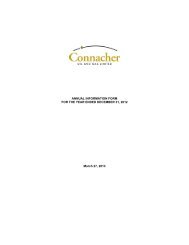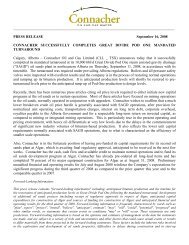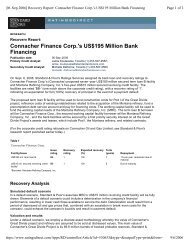ANNUAL REPORT 2011 - Connacher Oil and Gas
ANNUAL REPORT 2011 - Connacher Oil and Gas
ANNUAL REPORT 2011 - Connacher Oil and Gas
Create successful ePaper yourself
Turn your PDF publications into a flip-book with our unique Google optimized e-Paper software.
AR <strong>2011</strong><br />
PG 55<br />
3.11 Leases<br />
Agreements under which payments are made to owners in return for the right to use an asset for a period are accounted for as leases. Leases that<br />
transfer substantially all the risks <strong>and</strong> rewards of ownership are recognized at the commencement of the lease term as finance leases within property,<br />
plant <strong>and</strong> equipment <strong>and</strong> liabilities at the fair value of the leased asset or, if lower, at the present value of the minimum lease payments. Finance lease<br />
payments are apportioned between interest expense <strong>and</strong> a reduction of the liability. All other leases are recorded as operating leases, <strong>and</strong> the costs<br />
are recognized in net earnings (loss) on a straight–line basis.<br />
3.12 Foreign currency<br />
Foreign currency transactions<br />
Transactions denominated in foreign currencies are translated to the respective functional currencies of the entities at monthly average exchange rates.<br />
Monetary assets <strong>and</strong> liabilities denominated in foreign currencies at the reporting date are translated to the functional currency at the exchange rate<br />
prevailing on the reporting date. Foreign exchange gains <strong>and</strong> losses resulting from the translation <strong>and</strong> settlement are recognized in net earnings (loss).<br />
Foreign operations<br />
The assets <strong>and</strong> liabilities of foreign operations are translated to Canadian dollars at exchange rates at the reporting date, while their statements of<br />
operations, other comprehensive income (loss) <strong>and</strong> cash flows are translated at monthly average rates. The resulting foreign currency differences<br />
are recognized in other comprehensive income (loss). Upon divestment of all or part of an interest in, or upon liquidation of, a foreign operation, the<br />
cumulative currency translation differences are generally recognized in net earnings (loss). Foreign exchange gains or losses arising from monetary<br />
assets <strong>and</strong> liabilities that form part of the net investment in the foreign operation are recognized in other comprehensive income (loss).<br />
3.13 Financial instruments<br />
Financial instruments consist of financial assets, financial liabilities <strong>and</strong> derivative financial instruments <strong>and</strong> are initially recognized at fair value plus,<br />
in the case of a financial assets or financial liability not at fair value through profit or loss, transactions costs. Measurement in subsequent periods<br />
depends on whether the financial instrument has been classified as “fair value through profit or loss”, “loans <strong>and</strong> receivables”, “available–for–sale”,<br />
“held–to–maturity”, or “financial liabilities measured at amortized cost“ as follows:<br />
Financial assets<br />
Financial assets comprise cash, trade <strong>and</strong> accrued receivable <strong>and</strong> investment in equity securities.<br />
Trade <strong>and</strong> accrued receivables are classified as “loans <strong>and</strong> receivables” <strong>and</strong> recorded at amortized cost less any impairment.<br />
Investments in equity securities are classified as available–for–sale <strong>and</strong> are carried at fair value, less any impairment. Unrealized gains <strong>and</strong> losses<br />
other than impairments are recognized in other comprehensive income (loss). On disposal, net gains <strong>and</strong> losses previously deferred in accumulated<br />
other comprehensive income (loss) are recognized in net earnings (loss).<br />
Financial liabilities<br />
Financial liabilities comprise trade <strong>and</strong> accrued payables, Senior Notes, Convertible Debentures <strong>and</strong> the amounts outst<strong>and</strong>ing under the Revolving<br />
Credit Facility.<br />
Trade <strong>and</strong> accrued payables <strong>and</strong> Senior Notes are classified as “financial liabilities measured at amortized cost” <strong>and</strong> are measured at amortized cost<br />
using the effective interest rate method.<br />
Convertible Debentures are classified as “fair value through profit <strong>and</strong> loss” whereby they are carried at the fair value at each reporting date.<br />
Unrealized gains <strong>and</strong> losses on remeasurement to fair value at each reporting period–end are recognized in net earnings (loss).<br />
Transaction costs relating to the Revolving Credit Facility are amortized over its term using the straight line method. The Facility is measured at<br />
amortized cost, net of transaction costs, in the event that amounts are drawn <strong>and</strong> outst<strong>and</strong>ing under the Facility at the reporting period-end. In the<br />
event no amounts are outst<strong>and</strong>ing at the reporting period-end, unamortized transaction costs are included in other assets.<br />
Derivative financial instruments<br />
Derivative financial instruments comprise investments in share purchase warrants, risk management contracts <strong>and</strong> embedded derivatives.<br />
The investment in share purchase warrants is classified as “fair value through profit <strong>and</strong> loss” whereby it is carried at the fair value at the reporting<br />
date. Unrealized gains <strong>and</strong> losses on remeasurement to fair value at each reporting period–end are recognized in net earnings (loss).<br />
The company enters into certain risk management contracts in order to reduce its exposure to market risks from fluctuations in commodity prices,<br />
foreign currency <strong>and</strong> interest rates. These instruments are not used for speculative purposes. The company has not designated its risk management<br />
contracts as effective accounting hedges <strong>and</strong> thus has not applied hedge accounting. As a result, all risk management contracts are classified as<br />
“fair value through profit <strong>and</strong> loss” <strong>and</strong> recorded on the balance sheet at fair value at each reporting date. Realized gains or losses from financial<br />
risk management contracts are recognized in net earnings (loss) as the contracts are settled. Unrealized gains <strong>and</strong> losses are recognized in net












